어스돈 (Earthdawn) + 던전 (Donjon)의 어스돈존을 어스돈 + 세기의 혼 (Spirit of the Century)으로 바꿔서 진행하기로 했습니다. 아직 석한군 주인공 제작을 못해서 세혼판 키브와 그바라그가 미완인 채로 과거 외전 겸 규칙 테스트를 해보았습니다.
Tag Archives: 세기의 혼
Thoughts on Dragons of the Yellow Sea
John Kim gave me the link to a new Spirit of the Century campaign page, Dragons of the Yellow Sea, and boy is that cool or what! I read His Majesty’s Dragon and thought the idea of dragons in real life was cool, though the book didn’t grab me otherwise. But the thought of dragons on Jejudo… that’s just delicious. (And those sturdy, clever little island ponies? ‘Yum’ indeed for our scaled friends. 😉
John asked me about possible hooks and tropes for a Korean campaign set in the 1860’s, though he is wisely unconcerned with historical accuracy. This post far exceeded LiveJournal’s max for comments, which is why I moved it here. You know what they say about being careful what you wish for…
Society
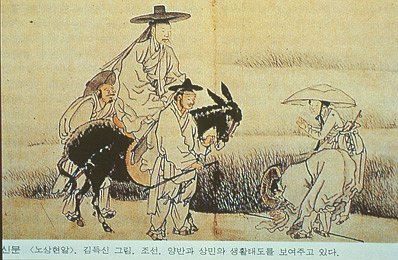
Yangban on donkey with Nobi attendants, commoners bowing by the roadside
In addition to taxes paid with rice or other commodities (by the nineteenth century paying in currency was fairly common as well), commoners also paid with labor, working on major state-run constructions like fortifications, and could be drafted into the army. These were all sources of widespread misery, as you can imagine: Overworked peasants dropped like flies from starvation and contagion. If you had money you could pay off the labor tax with cash, and the steady rise of rich commoners was another source of social pressure. Heck, some commoners were actually buying impoverished noble families’ Jokbo (family records) to pass themselves off as nobility–effectively buying stature with cash.
The indentured servants, the Nobi, worked in the noble households and could be bought and sold. An individual or family could also have their free (common, or even noble) status stripped away and become Nobi, usually because they were associated with some major crime like treason. The archetypal story is one where a nobleman is accused of treason and is messily executed, then his entire family are slaughtered or sold into servitude. This status of servitude was hereditary, so this meant effective annihilation for the whole family.
So there are some interesting social pressures in regards to class. There’s the traditional oppressive class system, perpetuated for, oh, easily a thousand years. There’s also resentment building steadily against it, with the growing recognition of the horrible iniquities and the rise of some rich commoners. For the Yangban the new development is a source of alarm and righteous indignation; for the Yangin and especially the Nobi the old system is a source of growing resentment. The historical details are unimportant, but these kinds of opposing pressure could make for some really meaty conflicts. Korea had its share of peasant and slave uprisings, particularly when times were bad with famine and such.
Maybe dragons played a role in such conflicts as well?
You could bring class into play in a number of ways, one of which is the issue of class and dragons. What class of people ride dragons? Many Yangban considered physical exertion beneath them. Chosun was a country that consistently looked down on martial pursuits in favor of scholarly ones, so soldiers, even noble ones (Mushin), were considered inferior to the bureaucrat scholars (Munshin). Still, “Yangban” does mean the “two Bans”–the Munban, which is the bureaucracy, and the Muban, which is the military. Overall I’d imagine the noble-born officers who passed the relevant state exam (the Mugua) would be the most likely candidates for dragon riders.
Of course, dragons can’t be expected to give a fig for human conventions, so I can definitely imagine the pesky creatures choosing commoners or even some slave who was sweeping the yard or carrying loads. Or a bureaucrat who must now lower himself to officerhood. Or even–horror of horrors–a woman! It would actually be better if it were a commoner or slave woman. I can imagine many a noble lady fainting dead away at the idea of her daughter running around with men and engaging in sweaty physical exertion.
Women
The status of women was, well, pretty bad. They couldn’t inherit, had no right to leave their husbands… hell, even remarriage was frowned upon for widows. This was worse for noblewomen because they were more tightly bound by repressive moral expectations. Common women had more leeway, but overall it was pretty severe.
At least if you were born noble it was unlikely you were illiterate, though your education was limited compared to noblemen. Hangul, the letters created for the Korean language, was (and is) immensely easier to learn than Hanja, the Chinese characters used by the elite, so women turned to Hangul for self-expression. The bureaucrat elite looked down on Hangul as Un-mun, the woman’s letters, but many examples of Hangul literature by Chosun noblewomen survive and are highly regarded today.
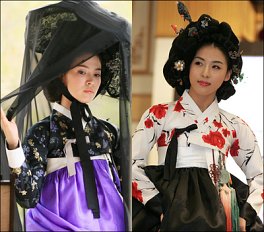
Kisaeng
Cultural themes
One recurring trope in comical Korean folklore is the plucky, worldly, clever commoner and the boorish, sheltered nobleman. That might be fun to work into the characters, kind of a two-man comedy routine coupled with social commentary.
Another recurring theme throughout history is that the central government is oppressive and uncaring of the people, so the people had damn well better rely on themselves if they want to get anything done. Yet reverence for the king’s person was almost absolute unless he was really, really tyrannical. Mostly it was the Yangban who bore the brunt of resentment.
The local government was sometimes good, sometimes bad, but the central government was almost always seen as corrupt and untrustworthy.
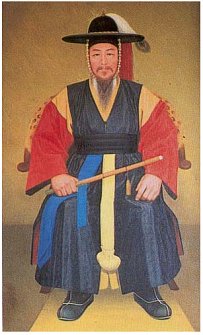
Lee Sunshin
This is a fairly typical hero’s tale in the Chosun era; there’s no stigma for a hero to be accused by the state, since there’s no trust in government. If anything it adds to his heroic status, because he’s made powerful people nervous. The hero’s tale also doesn’t end in revenge and bloodbath like it might in Japan. Yes, the hero was horribly wronged; no, he’s not going to take revenge, rather he’s going to prove his righteousness through heroism or cleverness, which will shame the person who wronged him. The hero will be triumphantly restored if it’s a happy story, and die tragically or leave for greener pastures if it’s a sad one. Either way it’s society that will judge the villain, not the hero him/herself.
Weaponry
Korea never did share its neighbor’s fetish for swords, though they were commonly used. (Korean swords share a superficial resemblance to the katana but were actually very different, and were used differently.) The weapon with the greatest hold on popular imagination was probably the bow. (On a probably unrelated but fun note, check out the Korean Olympic team’s track record in archery.) Jumong, founder of the ancient kingdom of Goguryoh, is a prime example of a legendary marksman. So was Lee Sung-Kié, the founder of Chosun.
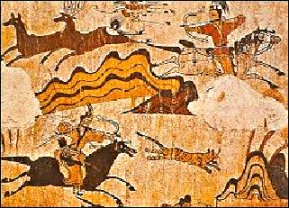
Goguryoh hunters
Of course, there’s no need to dispense with more modern weapons, either. Remember, gunpowder was a Chinese invention, and Korea also received a painful lesson on the power of firearms when the Japanese used them in their sixteenth-century invasion of the peninsula. Within years the Koreans were firing back with guns of their own.
Dragon folklore
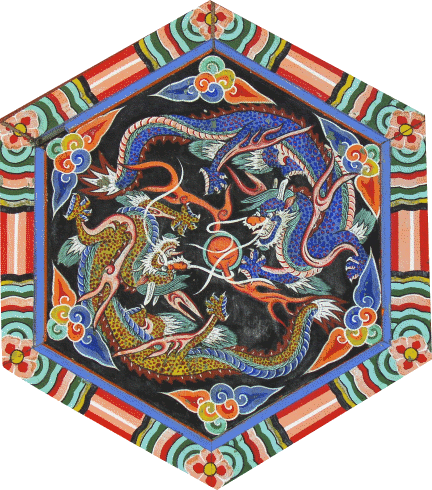
Blue and Gold Dragons
Regarding the traditional affinity with water, the king of the sea was called Yong-Wang, the Dragon King. There was also an ancient king (Munmu-Wang in the 7th century, 30th king of Shilla and the first king to unite the peninsula if you want specifics) who had his remains buried at sea so he could rise as a dragon and protect the peninsula from the marauding Japanese. His watery grave is a rocky outcropping in the Eastern Sea (or the Japanese Sea as it’s commonly known outside of Korea), about two hundred yards around. It’s called Sujung-neng, Underwater Grave, or Dai-Wang-Am, the Great King’s Rock.
Another important dragon in Korean mythology is Choyong. He’s one of the seven sons of the dragon of the Eastern Sea, who became the retainer of a 9th century king. Heck, maybe he was even a progenitor of latter-day dragons. Evidently he lived in human form among humankind, though.
The king (Hun-gang-wang, 49th king of Shilla) gave Choyong a beautiful wife, so beautiful that Yokshin, the spirit of contagion, became enamored of her and took on man-form (one version of the story says Choyong’s own likeness) to sleep with her. Choyong, coming home late at night, saw them lying together, but instead of getting angry he withdrew dancing and singing:
On a bright moonlit night in Seoul
I come late from carousing
In my marriage bed
I see four legs.
Two are mine
But what of the other two?
Once they were mine
But they were taken, so what can I do?

Choyong's likeness
Japan
I notice I keep mentioning Japan, so here’s a brief rundown on cultural attitudes: The Koreans traditionally thought of the Japanese as savages, pirates and marauders with no culture or history. (They were wrong, fatally so, but when have neighboring countries ever lacked for mutual prejudice?) With China, the font of all culture and civility (yeah right), as Korea’s traditional patron, the defeat of China by Japan was a huge shock.
Also, the coastal dwellers in particular suffered from Japanese pirate attacks, so there was hostility going on in that direction, too. Then there was the invasion in the sixteenth century during which the whole country suffered. (Imjin Waeran, “the attack of the Puny People in the year 1592”) One common derogatory term for Japanese is Jjokbari, “footpieces,” regarding their distinctive footwear; another is Waenom, “puny bastard(s),” mocking their height.
Wow, that is one LONG post. I tried to tickle the imagination rather than give a history lesson–I’m note sure how well I succeeded.
레니엔의 사건일지 1화
세기의 혼 + 강철의 연금술사 1:1 플레이, 레니엔의 사건일지 1화입니다. 세기의 혼 규칙을 익히려는 의도도 있는 플레이인 만큼 규칙에 대한 내용을 주석으로 달았습니다.
사무실도, 조수도 없이 자동차와 카폰으로 영업을 하는 초안습 사설탐정 레니엔은 저녁 7시쯤 친구 멜리사에게 전화를 받습니다. 군의 일은 뒤끝이 좋지 않으니까 안 하겠다며 끊으려는 레니엔에게 멜리사는 그런 일이 아니라며, 신세진 것도 있고 해서 저녁 해결해줄 테니 8시까지 시내의 고급 음식점으로 나오라고 합니다.
멜리사가 왜 자신에게 연락하는지 궁금해진 레니엔은 군의 아는 사람에게 전화해서 군의 동향을 살핍니다. 대체로 평온하지만 레니엔과 멜리사의 스승이 죽은 사건 후로 현자의 돌은 여전히 극비사항이고, 스승이 속했던 소수파에 대한 숙청은 암암리에 계속중이라는 정보를 얻습니다.[footnote]연락 기능 사용, 난이도는 보통, 결과는 환상적. 30분 걸릴 것으로 예상했지만 성공수 중 두 개를 진행자 멋대로(..) 써서 소모 시간 두 단계 감축, 몇 분으로 줄였습니다.[/footnote] 시간이 꽤 남은 그는 이발소에 들른 후 약속 장소로 나갑니다.[footnote]’방금 이발한 말쑥한 모습’ 임시 면모를 제안했습니다만..(..)[/footnote]
식당에 도착한 레니엔의 허름한 모습을 보고 직원은 들여보내주지 않으려고 하지만(주:’돈과는 인연이 없다’ 면모 강제발동, FP +1), 멜리사의 이름을 대자 무사통과. 뜻밖에도 멜리사는 최신예(?) 애인인 데이비드 칼슨 중위와 군 도서관에 근무하는 젊은 아가씨인 에밀리 레이크 준위와 함께 기다리고 있었죠. 칼슨 중위와 악수하며 예리한 레니엔은 그가 꽤 의심이 많은 인물이라는 눈치를 채고, 자신은 멜리사와 사귄 적이 없으니 잘 지내보자고 합니다.(주:사람보는 눈 판정해서 ‘의심 많음’ 면모 파악. 원래 30분이 드는 판정이지만 성공수를 전부 들여 잠깐으로 단축. 원래대로라면 칼슨은 사교로 저항 굴림을 하지만 귀찮아서 생략.) 뭐 이번 남자는 얼마나 갈지 의문이긴 하지만요.
멜리사는 에밀리가 레니엔을 몹시 만나고 싶어했다며 레니엔에게 저녁은 공짜니까 잘 해보라는 협박(?)과 함께 칼슨을 데리고 나갑니다. 그리고 누가 여자와 인연 없는 인생 아니랠까봐(주:’여자와 인연이 없다’ 면모 강제 발동, FP +1) 레이크 준위가 레니엔을 만나고 싶어했던 건 사건 의뢰 때문이었습니다. 10대의 남동생이 얼마 전에 사라졌는데, 가출이 잦은 아이인지라 경찰에서도 심각하게 취급하고 있지 않다는 것이죠. 동생 토미가 실종되기 얼마 전부터 조직 폭력배와 관계가 있는 연금술사인 ‘슬릭 리키’와 어울렸기 때문에 연금술사 탐정을 찾았는데, 그걸 멜리사가 오해한 것입니다.
어쨌든 돈이 필요한 레니엔은 수임을 받아들이고, 혹시 토미와 관련해 접촉이 있을지 모른다며 에밀리를 걸어서 바래다줍니다. 어두운 골목을 걷던 중 그는 누군가 골목길에 숨어서 기다리는 것을 간파하고[footnote]나쁜 지각력 결과를 탐정 면모를 발동해 재굴림으로 좋음으로 올리고 (FP -1), 상대의 기척 죽이기 결과는 보통[/footnote], 괴한이 에밀리의 핸드백에 손을 뻗으려 하자 허공에 총을 발사해서 겁을 주어 쫓아냅니다.(주:이미 지각력과 기척 죽이기 대결에서 승리했으니 대응 시간은 충분, 허공 발포이니 판정 없이 간접 행동으로 장면에 ‘사람들이 달려올 것이다’ 면모 부여, 자신의 행동으로 부여한 면모이므로 첫 1회는 무료 발동) 그리고 괴한이 도망치는 동안 놀란 에밀리를 달래서 역시 그 자리를 벗어납니다.
레니엔은 에밀리에게 핸드백에 중요한 물건이라도 들었냐고 묻지만, 에밀리는 자신이 알기로는 없다고 대답합니다. 그 길은 늘 다녔지만 그런 일은 처음이라고… 군인인 건 몰랐다 쳐도, 혼자 있는 여자도 아니고 남자 동행이 있는 여자를 소매치기가 굳이 노렸다는 점도 좀 이상하고요. 어쨌든 의뢰인을 무사히 집에 바래다준 레니엔은 슬릭 리키라는 연금술사에 대해 조사하기 위해 뒷골목에 아는 사람이 있는 부둣가로 향합니다.
국가 연금술사 멜리사 헤이워스
강철의 혼에 나올 예정인 주요 조연 내지는 준(準)주인공 멜리사 헤이워스입니다.
시트
면모
“어휴~! 그저 조 기집애가 제 성질을 못 이겨서!!”
천하의 둔치
한번쯤 다시 보게 되는 미인
바보 같은 렌 녀석
전격(電擊)의 연금술사
“걔? 사귄 남자 다 파악하려면 전속 비서 하나는 있어야 될걸.”
국가를 위해 일한다는 긍지
스승이 죽은 진상을 밝히겠다는 집념
우수한 사격수
한 남자하고 3개월을 못 넘긴다
기능
엄청나다 – 신비학
대단하다 – 총기, 지도력
좋다 – 과학, 지각력, 주먹질
괜찮다 – 위협, 운전, 공감, 의지
보통 – 자원, 운동신경, 끈기, 학술, 수사
스턴트
연금술 – 연성 가능
준비된 연성진 – 호박석에 연성진을 박은 구리 팔찌로[footnote]왜 호박석과 구리인지 아시는 분은 가산점(?)[/footnote] 공기를 플라스마 상태로 만들어 원하는 방향으로 전기를 방전
트릭 샷 – 무생물을 쏘는 총기 판정에 +2
쌍권총 – 피해 +1, 총기를 무장 해제하려는 시도에 대한 방어 +1
졸개[footnote]왠지 악당스런 스턴트이긴 합니다만..(..)[/footnote] – 각 장면에 보통 수준의 부하 2~3인 대동 가능, 3개의 향상 제공. 각 향상으로 부하 수를 +3, 혹은 그중 셋의 수준을 +1 (최대 좋음)
강철의 혼 – 연금술 특칙
세기의 혼 (Spirit of the Century) 규칙도 익힐 겸 초보자님과 시간 나면 세기의 혼 규칙, 강철의 연금술사 배경으로 플레이하기로 했습니다. 세기의 혼과 강철의 연금술사는 기술 수준도 거의 비슷해서 파일럿 기능 정도만 빼면 기능 목록도 그대로 호환되지만, 연금술은 원래 규칙에 없죠. 그래서 스턴트 규칙을 이용해 만들어 보았습니다.
연금술 관련 스턴트
관련 기능: 과학 신비학(주:과학으로 할지 학술로 할지 좀 고민했는데, 강철의 연금술사에 나온 얘기를 보면 일단 연금술 사용은 과학이 맞는 것 같습니다. 연금술에 대한 지식 중 과학이 아닌 부분, 예를 들어 현자의 돌에 대한 문헌 조사 같은 것은 학술 기능이겠지만요. 신비학을 생각 못했군요. 과학보다는 신비학이 아무래도 가까우니 이쪽으로 하지요. 지식 부분도 신비학으로 판정하면 될 테고요.)
연금술
연성진을 그려서 발동함으로써 신비학 기능으로 공격, 간접 행동, 막기 등을 할 수 있습니다. 내려는 효과와 규모에 따라 난이도와 소모 시간이 다릅니다. 기본 난이도는 보통이며, 기본 소모 시간은 30분입니다. 일반적인 규칙대로 성공차이 하나마다 시간을 1단계 줄일 수 있습니다. 미리 그려둔 연성진을 발동하는 것은 굴림 없는 순간 행동입니다.
준비된 연성진
선제조건: 연금술
연성진이 그려진 물건을 몸에 지니거나 그런 장소를 준비해서 순간적으로 발동합니다.(주:대표적인 예로 로이 머스탱의 장갑이 준비된 연성진 스턴트에 해당하겠죠.) 신비학은 여전히 굴리지만 소모 시간은 순간입니다. 준비된 연성진의 효과는 한 가지로 고정되며, 효과가 더 필요하다면 이 스턴트를 여러 번 택해야 합니다.
빠른 연성
선제조건: 연금술
연성 소모 시간이 두 단계 줄어듭니다. 준비된 연성진과는 달리 효과에는 제한이 없습니다. 불완전한 연성진을 지니고 다니다가 필요할 때 보충하는 식일 수도 있고, 연성진을 아주 빨리 그리는 숙련도를 표현한 것일 수도 있습니다.
문의 저편
선제조건: 연금술, ‘문의 저편’ 혹은 유사 면모
문의 저편을 본 연금술사는 연성진 없이도 연성을 할 수 있습니다. 단순히 인체 연성을 시도한 것만으로는 이 스턴트를 택할 수 없으며, 문의 저편을 본 기억이 면모로 있어야 합니다. 어떤 연금술이든 1 페이트 포인트를 들여[footnote]이래서 괴물 형제나 그들의 폭력 스승이 연금술을 남발할 때면 온갖 신체적, 심리적 약점이 불거지는 게지요. 면모 강제로 페이트 포인트 채우려고..(퍽)[/footnote] 소모 시간을 잠깐으로 줄일 수 있습니다. 역시 일반 규칙대로 성공 차이를 소모해서 순간으로 단축할 수 있습니다.
이런 식으로 대충 만들어봤습니다. 완전한 목록은 아니고, 이런 것도 가능하다는 예시에 더 가깝습니다만.
캠페인 구상 – 해방의 혼
옛날 옛적에 언더월드 외전으로 구상했던 것이지만, 독립 캠페인으로도 욕심이 나는 ‘해방의 혼’은 세기의 혼 (Spirit of the Century) 규칙으로 일제시대 이야기를 그리는 것입니다. 태평양 전쟁중 미국을 위해 대일본 첩보 활동을 벌인다든지, 임시정부가 내리는 임무를 수행한다든지 , 좌·우파의 갈등에 휘말린다든지 하는 얘기가 주가 되겠죠.
다만 가뜩이나 다루기 조심스러운 역사적 시기인데 펄프의 과장된 만화적 황당함이 얼마나 어울릴지는 다소 미지수이기도 합니다. 비행선으로 총독부를 점거, 일본을 뒤에서 조종하고 있던 사악한 닥터 가츠무라와 1백명의 닌자(..)를 무찌른 후 조선독립을 선포한다! 같은 스토리는 말이 안되는 점은 차치하고라도 짜증부터 날 거라는 생각이. 물론 그런 짓은 절대 안하겠지만 어쨌든 세기의 혼이 펄프적 황당함에 꽤 어울리게 짜여져 있는 건 사실이고…
그래서 펄프보다는 오히려 느와르적 분위기가 어울릴지도 모른다는 생각도 듭니다. 하나둘씩 동지를 잃어가며 혼탁한 현실 속에서 허우적거리는… 때로는 적과 동지의 구분마저 모호해지고, 거대한 싸움 속에서 사람 목숨은 파리만큼의 값어치도 없는 그런 비정한 분위기 말이죠. 면모 규칙이 내적 갈등을 표현하는데 매우 적합하기는 하지만 그럼 또 세기의 혼 규칙의 색채는 좀 살리기 어려울듯한 게 문제.
뭐 그런저런 이유로 세기의 혼은 다른데 써먹는 것이 나을지도 모르겠습니다. 강철의 연금술사 배경을 차용해다가 하는 ‘강철의 혼’ 캠페인이라든지. 연금술, 유사과학, 과장된 액션 등은 여러모로 펄프적 분위기인데다 세기의 혼에서는 학자와 기술자가 매우 유용한 유형이니… 뭐 어느쪽이든 지금 하는 캠페인들이 끝나기 전에 마스터링을 늘릴 생각은 추호도 없으니 천천히 생각해볼 문제겠지만요.
세기의 혼 도착!
음하하하하하하하!!!!
발매에 앞서 주문했던 세기의 혼 (Spirit of the Century) 하드커버 한정판이 드디어 도착했습니다!!
앞표지 안쪽에는 세 작가 (로버트 도노휴, 프레드 힉스, 레오나르드 발세라)의 사인이 들어가 있고, 끼워져 나온 책갈피 두장 뒷면에는 형용사 사다리와 시간 단계, 거리 단계, 기능 목록 등 진행에 참고할만한 규칙이 발췌되어 있습니다. 코팅된 세기클럽 회원카드도 끼워넣어져 있군요. (회원번호 97, 센츄리온급 되겠시며..ㅡㅡV)
책도 참 예쁘고 튼튼해 보이고, 크기도 소설책보다 조금 큰 정도라 400여쪽이라는 (인디 RPG로서는 획기적인) 양에 비해 휴대도 편해 보입니다. 종이 질도 좋고… 질낮은 종이와 울퉁불퉁한 페이지 가장자리 때문에 ‘펄프’라는 이름이 붙은 장르를 지향하는 RPG로서는 역설적일 수도 있지만, 하여튼 책 제본도 깔끔하고 좋습니다.
평소에는 PDF로 충분히 만족할 정도로 물리적인 책에 대한 집착이 없는지라, 세기의 혼에 서슴없이 50불을 처넣은(..) 행동은 저로서도 당황스러울 지경입니다. 어쨌든 그만큼 기쁨도 크군요. 평소 너무너무 좋아했던 페이트 RPG가 이렇게 훌륭한 규칙책으로 나오다니, 50불이 아니라 100불이었어도 행복했을 지경이니까요.
그 외에 최근에 지른 RPG로는 소서러 (Sorcerer RPG)와 화륜전설 (Burning Wheel)이 있습니다. 소서러야 뭐 포지계열 인디 RPG의 고전인데다 최근 높이 평가받고 있는 배경설정인 무의 사전 (Dictionary of Mu)이 나와서 결국 질러버렸죠.
화륜전설 (오륜전설 패러디 번역?) 같은 경우 대개의 인디 RPG와 달리 경량 규칙은 아니지만, 극적인 플레이를 지원하는 신념 및 본능 규칙과 박진감있는 전투규칙으로 널리 호평을 받고 있습니다. 반지의 제왕 풍의 판타지를 더없이 잘 받쳐준다는 평이 있지만, 저는 염불보다는 잿밥인지라(..) 열사(熱沙)전설: 성전(聖戰) (Burning Sands: Jihad)이라는 무료 배경 때문에 질러버렸죠. 이게 듄을 기반으로 한 배경이라 듄 RPG로 사용할 생각이 있거든요. 과연 역량이 따를지는 그 다음 문제입…
문제는 돌리는 건 둘째치고 언제 다 읽을 것이냐…이지만 어떻게든 되지 않겠어요? 로키의 RPG 생활은 오늘도 즐겁습니다!
세기의 혼이 내 손 안에!
제가 멋대로 ‘세기의 혼’이라고 부르기 시작한 Spirit of the Century를 사서 보기 시작했습니다. 정확히는 아직 책이 나오진 않았고 11월 초쯤에 배송되겠지만, 미리 주문하면 무료 PDF가 나오기 때문에 그 PDF를 보고 있는 것입니다. 무려 420쪽짜리의 탄탄한 내용이라 보는 즐거움이 한가득! (광고하냐)
세기의 혼은 본래 무료 규칙책으로 나왔던 페이트를 수정해 펄프 장르에 적용한 것으로, 팬들 사이에서는 페이트 3.0으로 통합니다. (현재 번역중인 PDF가 1.0, 페이트 OGL SRD가 2.0, 세기의 혼이 3.0) 펄프에 특화돼 있긴 하지만 펄프가 워낙에 SF, 판타지, 공포물, 추리물, 수퍼히어로물 등 다른 많은 장르로 파생돼 나온지라 (아시모프, 하인라인, 하워드, 러브크래프트, 라이스…) 다른 수많은 장르에도 적용할 수 있을듯 합니다.
페이트는 원래부터 좋아하는 규칙이었지만 세기의 혼에 와서는 정말 마음에 들게 바뀐 점이 몇가지 있는 게, 우선 인물 제작이 훨씬 간단해졌다는 점입니다. 면모에는 더이상 칸수가 없이 유무만 있으며 (즉 ‘아틀란티스의 후예 □□’가 아닌 ‘아틀란티스의 후예’), 가장 복잡한 부분이었던 기능 피라미드는 이제 ‘엄청나다’를 정점으로 한 피라미드에다가 기능을 채워넣기만 하면 됩니다.
인물 제작에서 또 좋아진 부분은 주인공들이 전에도 서로 함께 일한 적이 있고 서로 알도록 짜여져 있다는 것. 어차피 모든 주인공은 ‘세기 클럽’의 구성원이므로 시작 전부터 서로 아는 사이인 것이 논리적이기도 하지만, 인물 제작 과정을 통해서 각 주인공은 두명의 다른 주인공을 알게 됩니다.
어떻게 하냐 하면, 총 5기의 인물제작 중 3기에 각 참가자는 자기 등장인물이 주인공인 펄프 소설의 제목과 대략의 내용을 정합니다. (예를 들어 ‘정글맨과 리키-티키의 눈’에서 정글맨은 고대 유적에 묻힌 전설의 유물 리키-티키의 눈을 찾는 밀렵꾼들을 물리친다! 라든지요.) 그리고 4기와 5기에는 다른 주인공의 펄프 소설에 주변 인물로 등장하는 것입니다. (예를 들어 정글맨은 4기에는 ‘마타 하리와 아틀란티스의 전설’에 출연하고, 5기에는 ‘닥터 D와 분노의 고릴라’에 출연할 수 있겠죠.)
각 기마다 그 기의 경험에 어울리는 면모를 두개씩 추가하기 때문에 주인공끼리의 공통된 경험이라든지 인간관계를 면모로 만들어 규칙 자체적으로 지원을 받을 수 있습니다. 예를 들어 4·5기를 거치면서 정글맨에게는 ‘정글맨은 마타 하리 좋아한다’라거나 ‘닥터 D는 백인치고 똑똑하다’ 면모가 추가될 수도 있는 것이죠. 또한 기존의 모험에서 새로운 모험의 실마리를 얻을 수 있다는 점도 편합니다.
판정 부분은 아직 다 보지는 못했지만 특히 마음에 드는 점은 장면이라든지 주변 인물, 혹은 다른 주인공의 면모를 주인공이 사용할 수 있다는 점입니다. 예를 들어 어떤 장면에 ‘어둡다’ ‘까마득한 절벽’ ‘화재’와 같은 면모가 있다면 페이트 점수를 들여 유리하게 이용할 수 있다는 점에서 전술성과 극적 재미를 둘다 확보한 규칙이라고 보입니다.
그 외에 페이트 1.0 규칙을 보면서 불확실했던 부분들을 명확하게 했다는 점에서도 높은 점수를 주고 싶군요. 저는 1.0 규칙만 봐서는 주인공의 면모에 의해서 불이익이 생기지만 주인공이 저항할 수 없는 것일 때 어떻게 할지 잘 알 수가 없었거든요. 예를 들어 ‘예쁜 얼굴만 보면 정신을 못 차린다’ 면모가 있는 주인공이 수상한 미녀에게 넘어가는 것은 참가자가 페이트 점수를 내서 자제시킬 수 있지만, ‘검은 불꽃 형제단의 원수’ 면모가 있다고 해서 검은 불꽃 형제단의 출연을 페이트 점수로 막는 것은 이상하니까요.
이 경우 3.0 규칙의 지침은 단순명쾌합니다. 검은 불꽃의 형제단이 등장하는 세션 전에 그 면모가 있는 참가자에게 고맙다는 의미로 페이트 점수를 미리 1점 주라는 것이죠. 또 배경 세계와의 연관, 특히 문제의 소지가 있는 연관을 포상하는 규칙이라고 할 수 있습니다. 이런 식의 명확화는 페이트의 기존 팬들에게도 유용하고, 전체 규칙의 완성도를 높인다는 점에서 마음에 듭니다.
펄프는 단일 장르라기보다도 하나의 마음가짐이기 때문에 세기의 혼으로 실제 펄프 캠페인을 돌릴 수 있을지는 잘 모르겠습니다. 국내에서의 친숙도 문제도 있고… 어쨌든 명확하고 잘 다듬어진 규칙 때문에라도 세기의 혼은 구입할 가치가 충분히 있었다고 생각합니다. 천천히 읽으면서 한장 한장 음미할 시간이 기대되는군요. ^^